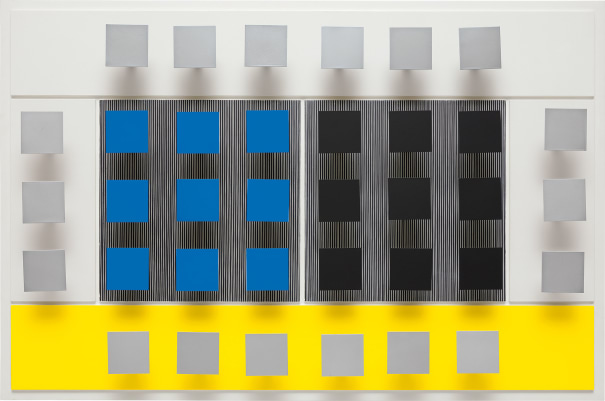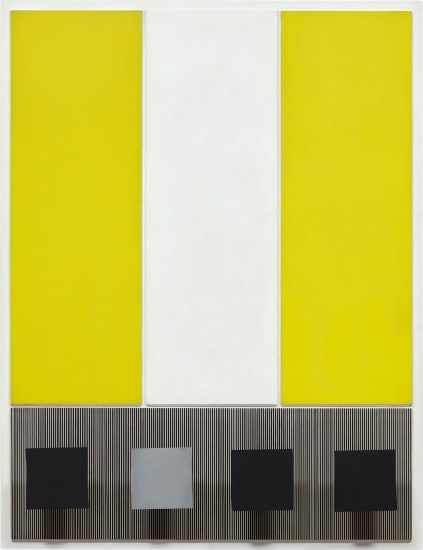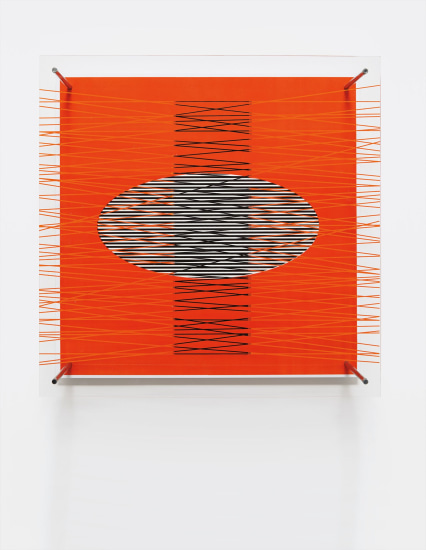Jesús Rafael Soto Cuadrado virtual azul, con gris signed, titled and dated "CUADRADO VIRTUAL AZUL, CON GRIS - SOTO - 1977" on the reverse painted wood, metal rod with nylon strings 32 1/4 x 32 1/4 in. (81.9 x 81.9 cm) Executed in 1977.
Provenance Collection of Arturo Buenaño, Caracas Collection of Gustavo Lagrave, Caracas Gómez Fine Art - Galería, San Juan Acquired from the above by the present owner Catalogue Essay “One concern that has haunted me throughout my artistic exploration,” Soto once observed, “is how to bring matter back to its essential value, i.e. energy; or in more concrete terms, how to transform material elements in my work into a chance state or vibration.” This pursuit of the immaterial (“the tangible reality of the universe”) shaped Soto’s practice through the critical postwar decades as he followed the progression of color from painting to optical vibration and finally into suprasensorial environments. He arrived in Paris in 1950 and drew within the Constructivist milieu of the Salon des Réalités Nouvelles and the Galerie Denise René, which included him in Le Mouvement (1955), the seminal period exhibition of optical and kinetic art. Motivated at first by the examples of Alexander Calder and Piet Mondrian Soto sought to create “a truly abstract art,” beginning with the early series Repetitions and Progressions. “At a given point,” he reflected, “I understood that I had to eliminate one of two liberties, and through this discovery, in 1957, I retained, almost mechanically, the tightly ruled background screen, leaving the superimposed element free.” Within this given framework of suspended metal wires and rods, Soto analyzed vibration in myriad variations and formats, shaping the immateriality of color in space and time. “Soto’s optical paintings keep the question of what is real and what is imaginary in perpetual suspension,” critic Guy Brett observed. “When he hangs a metal rod in front of a lined screen (his ‘sign’ reduced to its simplest terms) the optical interference of these two elements releases a third—the vibration—which is real to the eyes though it has no material existence. The rod is not exactly dissolved into vibrations, for then it would be absorbed into another medium and disappear altogether. The vibrations take the shape of the solid rod, tracing its movement in pulses, as if they were its shadow. But the situation is so finely balanced it could equally be that the solid rod is the ‘shadow’ of the energy pulses, which ‘really’ constitute the rod and everything else we see as solid stable objects in the world.” From a single bar at the top of Cuadrado virtual azul, con gris, a stream of thin metal rods hangs from transparent nylon threads before a dark gray square, flickering in shifting patterns of light and shadow against the lined ground. As in Tríptico a cuadrados virtuales (1974), a “virtual” square emerges amid the shimmering optical surface, produced here by the vibrations of rods painted blue at their center. The slightest movement of the steel rods induces a wavy moiré effect, dematerializing the blue square in the dynamic temporal space activated between the static support and the viewer. “Soto’s achievement has been to give a luminous imaginative force to the idea of continuum,” Brett remarked. “Forms are not localizable, it’s not possible to say: there are the forms and this is the space that contains them. Forms and space are continually creating each other, changing into each other.” This flux of fugitive lines and color is perceptual and interactive, the optical vibrations conditioned by the surrounding space and the ambulant viewer. “It has always been part of the poetry of Soto’s work to be half in the world and half out of it,” Brett concluded. “The rods oscillate between the abstract world of relations and the world of things. Unpredictable currents from the world of things activate and bring to life the painting’s space.” Abigail McEwen, PhD Read More Artist Bio Jesús Rafael Soto Venezuelan • 1923 - 2005 Jesús Rafael Soto was born in Ciudad Bolívar and studied at the School of Visual and Applied Arts in Caracas. During this period he became acquainted with Los Disidentes, a group of artists that inclu
Jesús Rafael Soto Cuadrado virtual azul, con gris signed, titled and dated "CUADRADO VIRTUAL AZUL, CON GRIS - SOTO - 1977" on the reverse painted wood, metal rod with nylon strings 32 1/4 x 32 1/4 in. (81.9 x 81.9 cm) Executed in 1977.
Provenance Collection of Arturo Buenaño, Caracas Collection of Gustavo Lagrave, Caracas Gómez Fine Art - Galería, San Juan Acquired from the above by the present owner Catalogue Essay “One concern that has haunted me throughout my artistic exploration,” Soto once observed, “is how to bring matter back to its essential value, i.e. energy; or in more concrete terms, how to transform material elements in my work into a chance state or vibration.” This pursuit of the immaterial (“the tangible reality of the universe”) shaped Soto’s practice through the critical postwar decades as he followed the progression of color from painting to optical vibration and finally into suprasensorial environments. He arrived in Paris in 1950 and drew within the Constructivist milieu of the Salon des Réalités Nouvelles and the Galerie Denise René, which included him in Le Mouvement (1955), the seminal period exhibition of optical and kinetic art. Motivated at first by the examples of Alexander Calder and Piet Mondrian Soto sought to create “a truly abstract art,” beginning with the early series Repetitions and Progressions. “At a given point,” he reflected, “I understood that I had to eliminate one of two liberties, and through this discovery, in 1957, I retained, almost mechanically, the tightly ruled background screen, leaving the superimposed element free.” Within this given framework of suspended metal wires and rods, Soto analyzed vibration in myriad variations and formats, shaping the immateriality of color in space and time. “Soto’s optical paintings keep the question of what is real and what is imaginary in perpetual suspension,” critic Guy Brett observed. “When he hangs a metal rod in front of a lined screen (his ‘sign’ reduced to its simplest terms) the optical interference of these two elements releases a third—the vibration—which is real to the eyes though it has no material existence. The rod is not exactly dissolved into vibrations, for then it would be absorbed into another medium and disappear altogether. The vibrations take the shape of the solid rod, tracing its movement in pulses, as if they were its shadow. But the situation is so finely balanced it could equally be that the solid rod is the ‘shadow’ of the energy pulses, which ‘really’ constitute the rod and everything else we see as solid stable objects in the world.” From a single bar at the top of Cuadrado virtual azul, con gris, a stream of thin metal rods hangs from transparent nylon threads before a dark gray square, flickering in shifting patterns of light and shadow against the lined ground. As in Tríptico a cuadrados virtuales (1974), a “virtual” square emerges amid the shimmering optical surface, produced here by the vibrations of rods painted blue at their center. The slightest movement of the steel rods induces a wavy moiré effect, dematerializing the blue square in the dynamic temporal space activated between the static support and the viewer. “Soto’s achievement has been to give a luminous imaginative force to the idea of continuum,” Brett remarked. “Forms are not localizable, it’s not possible to say: there are the forms and this is the space that contains them. Forms and space are continually creating each other, changing into each other.” This flux of fugitive lines and color is perceptual and interactive, the optical vibrations conditioned by the surrounding space and the ambulant viewer. “It has always been part of the poetry of Soto’s work to be half in the world and half out of it,” Brett concluded. “The rods oscillate between the abstract world of relations and the world of things. Unpredictable currents from the world of things activate and bring to life the painting’s space.” Abigail McEwen, PhD Read More Artist Bio Jesús Rafael Soto Venezuelan • 1923 - 2005 Jesús Rafael Soto was born in Ciudad Bolívar and studied at the School of Visual and Applied Arts in Caracas. During this period he became acquainted with Los Disidentes, a group of artists that inclu










Testen Sie LotSearch und seine Premium-Features 7 Tage - ohne Kosten!
Lassen Sie sich automatisch über neue Objekte in kommenden Auktionen benachrichtigen.
Suchauftrag anlegen